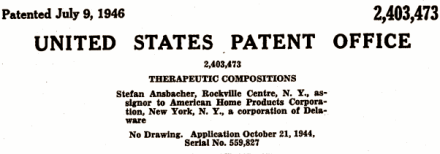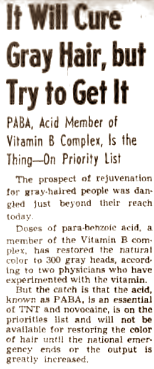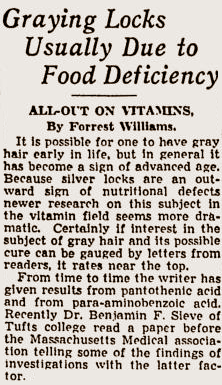1941: PABA returns colour to grey hair
If you go looking for supplements that help prevent hair from greying, sooner or later you'll come across PABA – or to give it its full name para-aminobenzoic acid [structural formula shown below]. And there are even studies which show that when given to people with grey hair it returns their hair to its original colour.
Animal data
The first study that mentions the anti-greying effect of PABA is also the first study that concludes that PABA is a vitamin. [Science. 1941 Feb 14;93(2407):164-5.] The article was published in 1941 in the prestigious Science, and was written by Stefan Ansbacher, an American researcher who worked at the Squibb Institute for Medical Research.

[FONT="]
[/FONT]
Ansbacher gave black rats synthetic feed and saw that they lost the colour in their hairs. When he added PABA to the feed, the animals' hair returned to its normal colour. In experiments with chickens, the birds did not grow well without PABA, and even died prematurely. Ergo: PABA was a vitamin. [Nutritionists later rejected this reasoning.]Ansbacher's publication took the form of a letter to the editor, the content of which was minimal. "Detailed data will appear elsewhere", was Ansbacher's apology.
Human data
A few months later another letter was published in Science about PABA. The author, the researcher Benjamin Sieve, wrote that he had managed to return the colour to several dozen grey-haired human subjects by giving them capsules containing PABA. Sieve experimented with different doses and concluded that 100 mg PABA daily was the most effective dose. [Science. 1941 Sep 12;94(2437):257-8.]

[FONT="]
[/FONT]
Like Ansbacher, Sieve was not particularly communicative about his research. "In view of the favorable results obtained I am continuing my experiments with a considerably larger series of cases in order to establish the optimum daily dosage of para-aminobenzoic acid", he wrote. "The detailed data will appear elsewhere."Larger study
At congresses Sieve and Ansbacher spoke jointly – several months after their letters had been published in Science - about experiments in which hundreds of people with grey hair had had their natural hair colour restored thanks to PABA.
PABA had no side effects, the researchers said, although the subjects did report having more energy, heightened interest in sex and in some cases the PABA supplementation resolved problems of infertility.
The press picked up on Sieve's and Ansbacher's study. The headline shown here on the right appeared on 13 November 1941 in the New York Post. In the 1940s PABA was not available commercially, hence the wording Try to Get It.Another newspaper, the Spokane Daily Chronicle, reported on 23 June 1942 [Spokane Daily Chronicle, June 23, 1942, p. 9.] that Sieve had meanwhile done trials with 460 subjects who had grey hair, and that after eighteen months most of them had got their original hair colour back. For some it only took two months.
Sieve achieved the best results with a combination of PABA and vitamin B5.
Patent
At the end of the war Ansbacher filed a patent for using PABA against greying hair. [US 2403473 A] In the application you can read that the effective doses lie between 50 and 600 mg PABA per day. In the experiments that Benjamin Sieve carried out 82 percent of the subjects reacted favourably to the supplementation, according to the patent.

[FONT="]
[/FONT]
More research
Other researchers have tried to replicate Sieve's results. In 1942 Harold Brandaleone of New York University published a small human study in which he had given 19 grey-haired subjects all kinds of vitamins. [Am J Medical Science. 1944;206: 315.] Only two of them regained their original hair colour. And as chance would have it – those two happened to take a supplement containing 100 mg vitamin B5, 200 mg PABA and 50 g brewer's yeast.
The attempts made by Chris Zarafonetis were less successful. [J Invest Dermatol. 1950 Dec;15(6):399-401.] This research who worked at Temple University in Philadelphia gave several dozen grams of PABA to people with skin ailments in 1950. Some of the grey-haired subjects regained their hair colour, but most did not.
Does it work?
So is PABA an effective hair recolourant? Although it looks as though two scientists tried to make PABA into a hype – and to profit from this – it may just actually work. We're not a hundred percent sure, and we don't know who PABA is likely to prevent from going grey and who not. After Zarafonetis's publication in 1950 PABA’s anti-greying properties disappeared from the scientific radar.
Source:
Science. 1941 Sep 12;94(2437):257-8.
If you go looking for supplements that help prevent hair from greying, sooner or later you'll come across PABA – or to give it its full name para-aminobenzoic acid [structural formula shown below]. And there are even studies which show that when given to people with grey hair it returns their hair to its original colour.
Animal data

[FONT="]
[/FONT]

|
Human data
A few months later another letter was published in Science about PABA. The author, the researcher Benjamin Sieve, wrote that he had managed to return the colour to several dozen grey-haired human subjects by giving them capsules containing PABA. Sieve experimented with different doses and concluded that 100 mg PABA daily was the most effective dose. [Science. 1941 Sep 12;94(2437):257-8.]

[FONT="]
[/FONT]

|
At congresses Sieve and Ansbacher spoke jointly – several months after their letters had been published in Science - about experiments in which hundreds of people with grey hair had had their natural hair colour restored thanks to PABA.
PABA had no side effects, the researchers said, although the subjects did report having more energy, heightened interest in sex and in some cases the PABA supplementation resolved problems of infertility.

|
Sieve achieved the best results with a combination of PABA and vitamin B5.
Patent
At the end of the war Ansbacher filed a patent for using PABA against greying hair. [US 2403473 A] In the application you can read that the effective doses lie between 50 and 600 mg PABA per day. In the experiments that Benjamin Sieve carried out 82 percent of the subjects reacted favourably to the supplementation, according to the patent.

[FONT="]
[/FONT]
More research
Other researchers have tried to replicate Sieve's results. In 1942 Harold Brandaleone of New York University published a small human study in which he had given 19 grey-haired subjects all kinds of vitamins. [Am J Medical Science. 1944;206: 315.] Only two of them regained their original hair colour. And as chance would have it – those two happened to take a supplement containing 100 mg vitamin B5, 200 mg PABA and 50 g brewer's yeast.
The attempts made by Chris Zarafonetis were less successful. [J Invest Dermatol. 1950 Dec;15(6):399-401.] This research who worked at Temple University in Philadelphia gave several dozen grams of PABA to people with skin ailments in 1950. Some of the grey-haired subjects regained their hair colour, but most did not.
Does it work?
So is PABA an effective hair recolourant? Although it looks as though two scientists tried to make PABA into a hype – and to profit from this – it may just actually work. We're not a hundred percent sure, and we don't know who PABA is likely to prevent from going grey and who not. After Zarafonetis's publication in 1950 PABA’s anti-greying properties disappeared from the scientific radar.
Source:
Science. 1941 Sep 12;94(2437):257-8.
